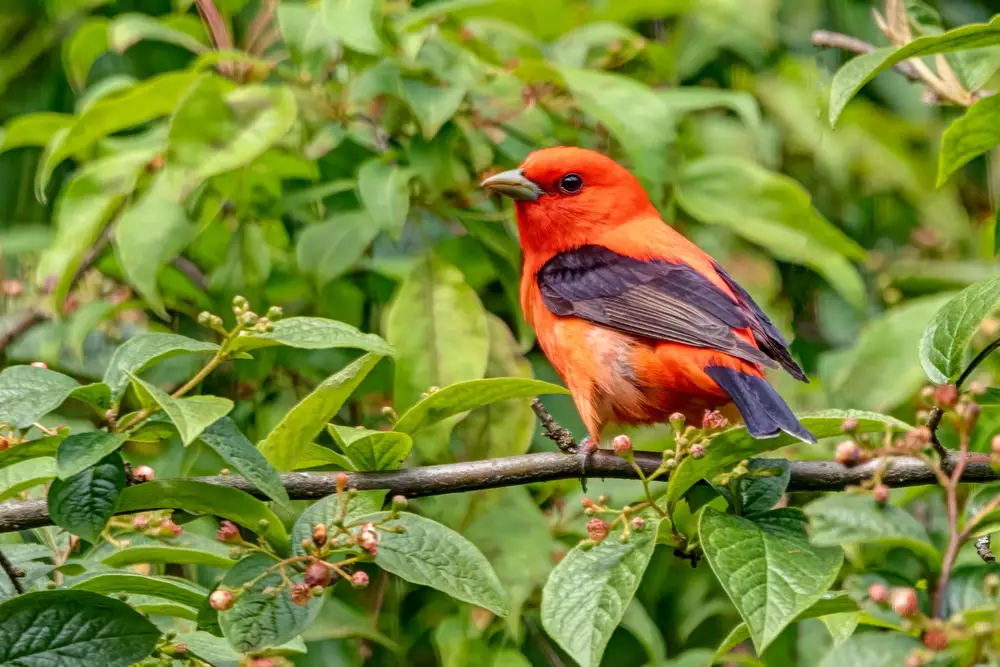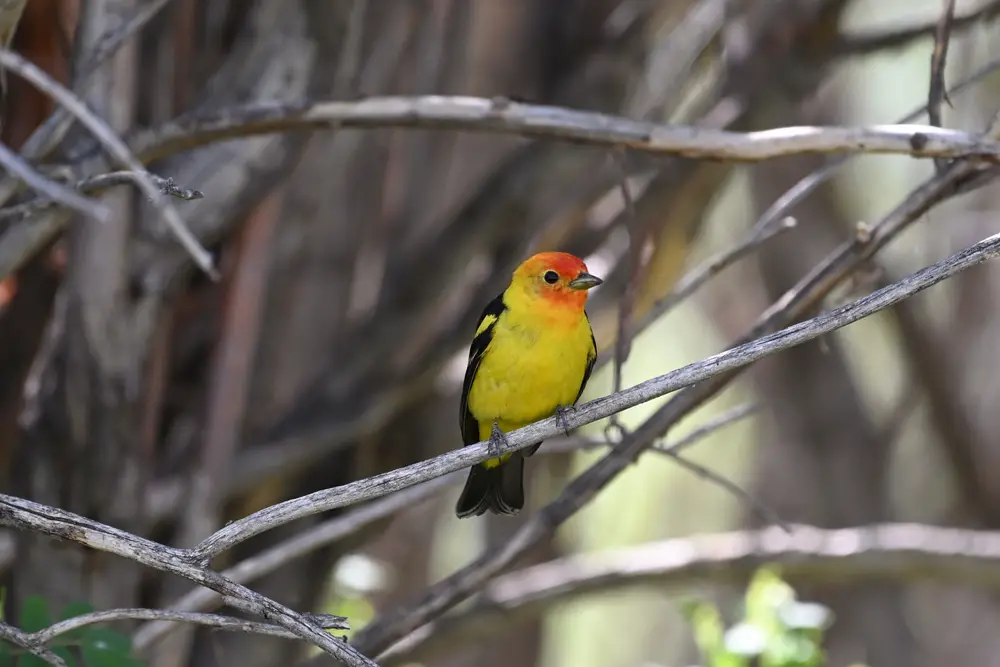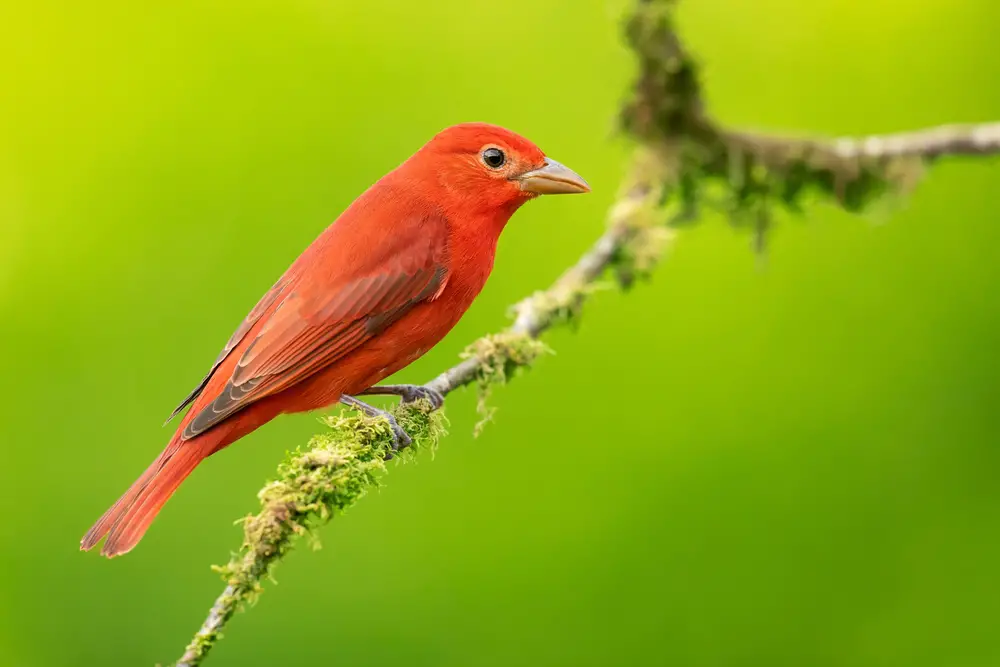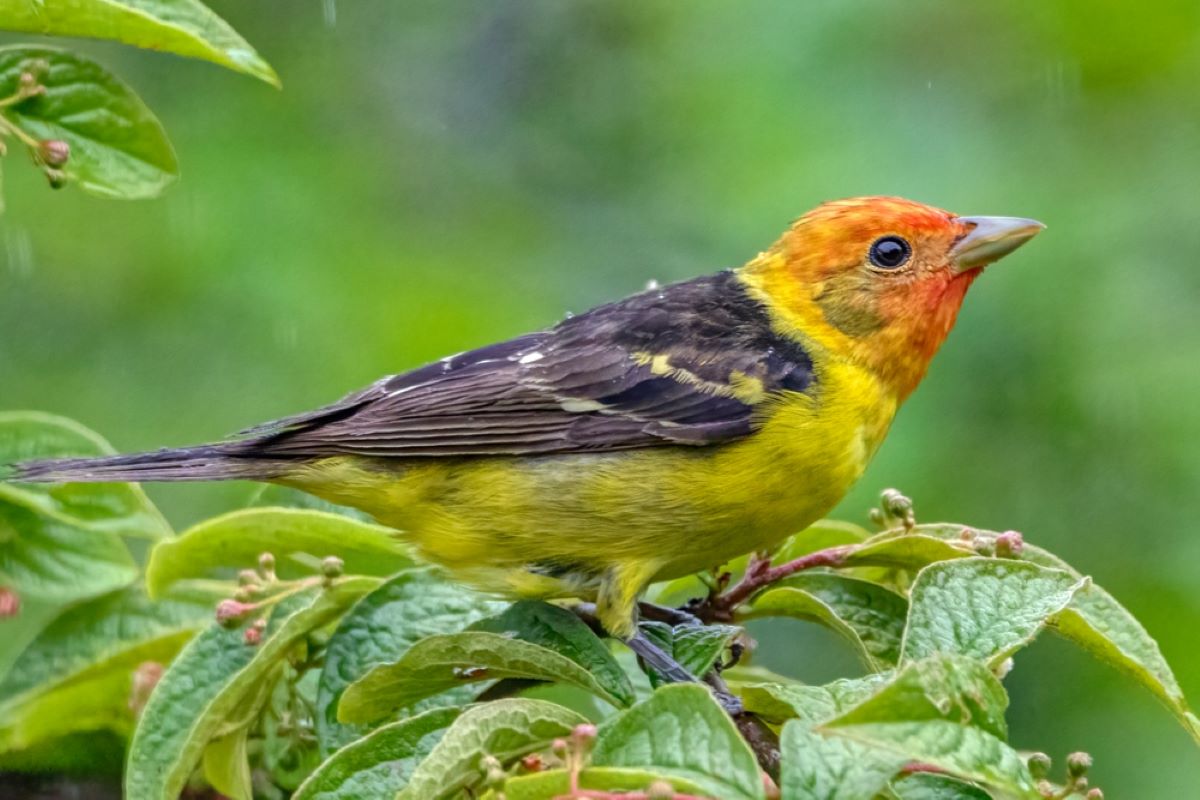Scarlet tanagers, summer tanagers, and western tanagers all share similar bird sounds. The scarlet tanager is a gifted singer known by birders for their distinctive chip-burr sound. Even though all three are commonly compared to the American robin’s birdsong, each has its own unique sound.
The scarlet tanager is a bright red songbird that spends its days singing from high perches in deciduous forests, parks, and well-planted backyards. Both male and female scarlet tanagers sing.
Summer tanagers and western tanagers are closely related to the scarlet tanager. These similar bird species have nearly identical songs. A few small differences help separate their song. Their distinct physical features can be used to identify them when their bird calls aren’t enough.
What does the Scarlet Tanager song (Piranga olivacea) sound like?
The scarlet tanager song is very similar to the American robin. Many bird lovers compare the scarlet tanager song to a robin with a sore throat. Despite the raspy quality of their notes, the scarlet tanager song is a sweet melody filling the forests. Their iconic chip-burr sound is the easiest way to know there is a scarlet tanager nearby long before you see them.
The scarlet tanager song varies from region to region, but they aren’t considered to have true dialects like some songbirds. The variations are thought to be influenced by song learning, which happens in their hatching year. Scarlet tanagers from the same region have similar songs, even if they don’t remain close neighbors with the birds they learned the song from.
The female scarlet tanager’s song is softer, sung in response to his call notes while she’s building a nest or tending to their young. Even though they have a similar song, the pair look nothing alike. Male scarlet tanagers are bright red birds with black wings and black tails. Females are yellow with olive green wings and a yellowish olive head.
What does the song of the Summer Tanager (Piranga rubra) sound like?
Summer tanager song sounds quite like the American robin and the scarlet tanager. The summer tanager’s song is shorter than a robin’s song, with long pauses between the slurred chirps and whistles. Summer tanagers are also lower and raspier than both the robin and scarlet tanager.
Both males and females sing for communication while nesting and to alert to danger. Along with a shorter, more subtle version of the ‘chip-burr‘ song tanagers are known for; the summer tanager uses a series of clicks and chirps in its song. When startled, a sharp, high-pitched call note lets other birds know there is danger.
Male summer tanagers are easily mistaken for Northern Cardinals at first glance. Upon closer inspection, they are bright red all over, with black wing bars and some black feathering on their red tails. Female summer tanagers are yellow from head to vent, with reddish-brown wings and reddish feathers on their otherwise yellow tails.

What does the Western Tanager (Piranga ludoviciana) song sound like?
Western tanagers also sound very similar to the summer tanager. Their song is nearly identical, but the raspy quality is a little thicker, and the western tanager favors shorter phrases. Chirps come in short bursts, with a repeating up and down pattern much like a call and answer. The chip-burr phrase is less pronounced than the scarlet tanager.
Western tanagers are brightly colored birds with yellow and orange feathers reminiscent of the sunrise. Their heads are reddish-orange, shifting to a bright yellow around the throat and extending to the vent. They have black wings with yellow barring, a yellow back, and a black tail. Females are olive-yellow with dark gray wings and olive-gray shoulders.
What songbird family do the Western, Scarlet, and Summer Tanager belong to?
Tanagers from the Piranga genus have been reclassified, putting them in the family Cardinalidae. This family includes Northern cardinals, desert cardinals, grosbeaks, and buntings. Even though their classification changed and they are not true tanagers, birds from the genus Piranga kept their common names.
Piranga tanagers were once thought to be true tanagers, but classifications of many bird species have evolved as our knowledge grows. It’s clear from the similarity in plumage and genetics that these tanagers are more closely related to Northern Cardinals than true tanagers. Their vocalizations further solidified their connection to the bird of the family Cardinalidae.

Do tanagers mate for life?
Tanagers are monogamous birds who stick with one mate for life. In the Spring, adult male tanagers begin singing to attract females. Once they’ve chosen a mate, the pair get busy making a nest for their young. Like many monogamous bird species, they will find a new mate if something happens to theirs.
Tanagers typically have 1 brood a year, incubating them for around 12 days before they hatch. Tanagers are another common victim of brood parasitism by cowbirds. Tanager pairs keep watch, aggressively defending their nest from cowbirds they notice nearby. Sometimes cowbirds slip by unnoticed, kicking the eggs out before they hatch and lay their own.
While cowbirds pose a threat to tanager young, climate loss has a far bigger impact on the North American tanagers. Bird conservation efforts have helped the scarlet, summer, and western tanagers thrive. Considering this species typically only has about 4 babies a year, their steady population is a testament to the power of bird conservation efforts.
Where are tanager bird species found?
Tanagers are a migrant bird species found throughout North America. All three species on our list spend part of the year in the United States. During the winter months, they head south. How far south depends on the species.
Scarlet tanagers live in the eastern range of North America. Breeding season is spent in the eastern United States and along the shared border with Canada. After breeding season, scarlet tanagers migrate through the southern states and Mexico, heading for South America. Their winter home is concentrated on the northwestern side of South America.
Summer tanagers have quite a bit of range overlap with scarlet tanagers, but their breeding season range extends along the southwest into California and Mexico. Winters are spent in southern Mexico, the Caribbean, and South America. Summer tanagers are not found in Canada.
Western tanagers range the farthest north of the three species. During the breeding season, they can be found in parts of Yukon and the Northern Territories in Canada. Their winter migration stops in Central America.

What do tanagers eat?
Tanagers are insectivores, flitting from branch to branch in search of their favorite bugs. During the winter months, tanagers will also eat fruits and dried berries. Suet, high in protein, is great for these migrant birds. Having plenty of fat stored up for the long journey is an essential part of their survival.
Since tanagers are migrant birds, their diet varies throughout the year. Tanagers are more adventurous eaters than many insectivorous bird species. Scarlet tanagers eat bees and wasps, rubbing their stingers off on branches to avoid getting stung. Summer tanagers are also aggressive eaters and have even been observed trying to eat a small anole lizard!
Tanager Summary
Tanagers have long been a favorite of bird watchers, and it’s easy to see why. While the tanagers of the genus Piranga aren’t true tanagers, these beautiful birds are talented singers with interesting behaviors.
These avid day singers are often in mixed flocks with other songbirds like warblers, orioles, blackbirds, flycatchers, and vireos. Now that you know the different songs of the tanager bird species of North America, you’ll be able to recognize their songs amongst other day singers with ease.

